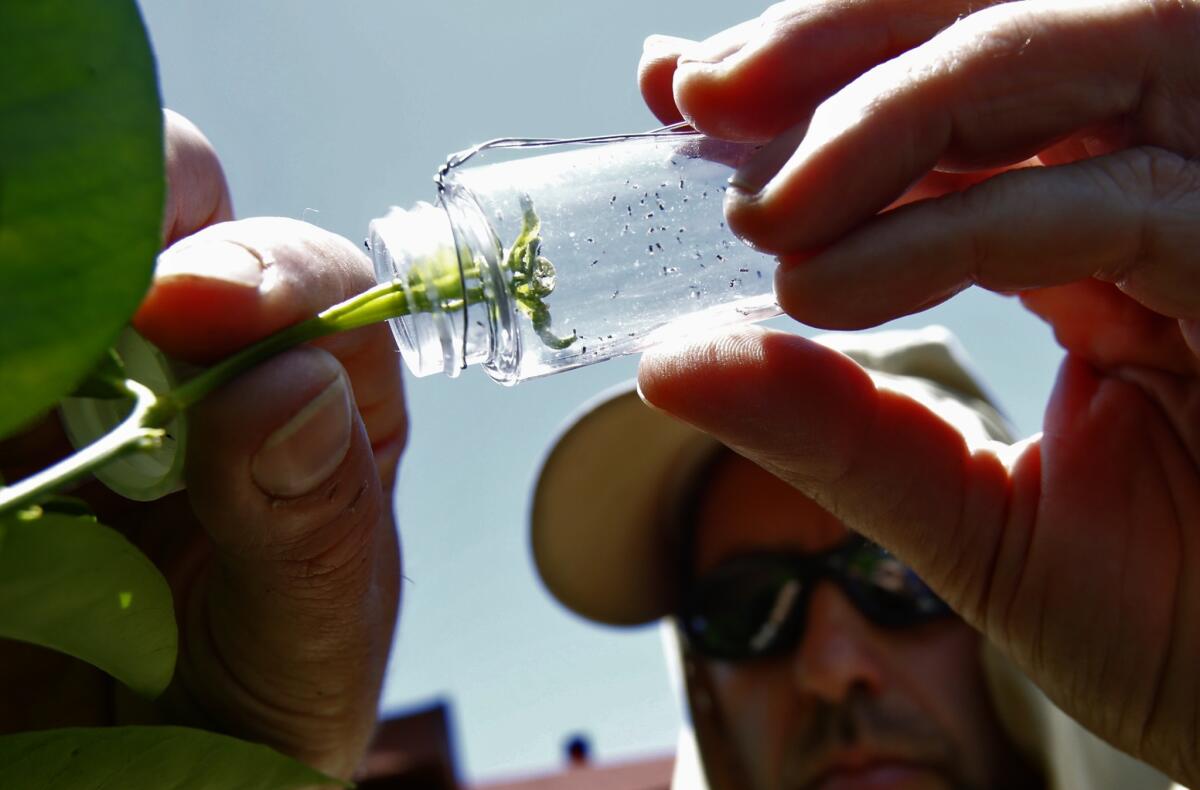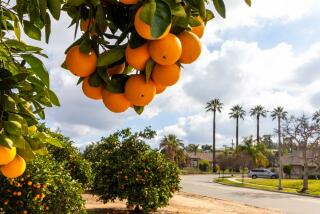USDA expanding release of parasitic wasp to combat citrus disease

The U.S Department of Agriculture on Tuesday said it would expand efforts to breed and release a tiny parasitic wasp in an attempt to contain the spread of a disease that has killed thousands of citrus trees in Florida and now is threatening California’s $2-billion citrus industry.
Huanglongbing, or citrus greening, is an incurable disease carried by the Asian citrus psyllid, a pest that has spread like wildfire across the U.S. There are full and partial quarantines in place in at least 14 states and U.S. territories.
Researchers since 2009 have been releasing the wasp, known by its scientific name Tamarixia radiata, in the U.S. The wasp is a natural enemy of the psyllid. Strains have been imported from Vietnam and Pakistan, and in California early data have shown that the parasite is taking hold in urban areas, where citrus growers hope the wasps will provide a buffer to prime commercial growing regions.
“This is a serious threat to the citrus industry in California,” said USDA Secretary Tom Vilsack in an interview with the Los Angeles Times. The breeding and release program has been expanded “so we can do a better job of containing and ultimately eliminating this disease.”
The USDA is committing $1.5 million to the breeding and release efforts in three states: California, Florida and Texas, officials said. That’s on top of millions that state and federal agriculture officials have kicked in to combat the citrus disease.
Over the next five years, more than $125 million appropriated by Congress will fund research efforts. The citrus industry is also exploring other strategies to contain the spread of the Asian citrus psyllid, Vilsack said. One promising method, Vilsack said, involves using thermal technology to heat the tops of citrus trees.
“The goal here is to invest in additional research and to use effectively the research we’ve already conducted in a targeted ... way,” Vilsack said.
In California, agriculture officials have enacted full or partial quarantines in 12 counties, including Santa Barbara, Ventura, Los Angeles and San Bernardino. Further north, Tulare and Fresno counties also have quarantines after the discovery of psyllids there.
Recent discoveries of the psyllids in Central California raise the fear that the pest is taking hold in prime citrus-growing areas, where it could threaten the state’s massive industry, which accounts for about 80% of U.S. fresh market citrus production. Florida’s citrus is primarily processed for juice.
Since 2010, California growers have spent about $15 million yearly to fight the psyllid. Much of that money goes toward massive detection and awareness efforts.
The pysllids don’t kill citrus trees. They’re merely the agent that spreads huanglongbing. An infected psyllid acts much like a dirty syringe, flying from tree to tree, feeding and depositing a bacterium each time it unfurls its needle-like mouth, much like a mosquito.
That’s why reducing the psyllid population is vital to making headway in preventing the spread of the disease.
“I think it’s an excellent idea,” said Mark Hoddle, a UC Riverside researcher who has been releasing a strain of the wasp that he and his wife, Christina, imported from the Punjab region of Pakistan, which has a similar climate to California.
Hoddle said the expansion would allow the California Department of Food and Agriculture to ramp up the scale of the breeding program.
The efforts by the Hoddles and a small team they’ve trained has been on a smaller scale, Mark said. “The process can be slow and tedious,” he said. “We have since transitioned the mass production of wasps to CDFA and they are working with financial support from the USDA to mass rear and release the parasites.”
State agriculture researchers are currently producing about 10,000 wasps a week and aim to produce about 1 million a year, Hoddle said.







